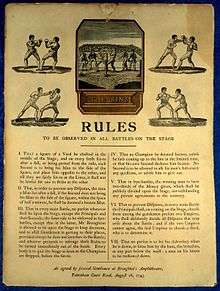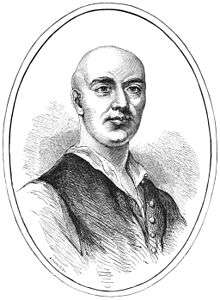Jack Broughton
John "Jack" Broughton (c. 1703 or 5 July 1704 – 8 January 1789) was an English bare-knuckle boxer. He was the first person to codify a set of rules to be used in such contests; prior to this the "rules" that existed were very loosely defined and tended to vary from contest to contest. His seven rules of how boxing [1] would be conducted at his amphitheatre (the largest and most influential at that time) evolved later into the London Prize Ring rules which are widely regarded as the foundation stone of the sport that would become boxing, prior to the development of the Marquess of Queensberry rules in the 1860s.


Fighting career
According to one source,[2] Jack Broughton was a farmer's son from the village of Baunton in Gloucestershire who left home at the age of 12 and made his way to Bristol where he worked at the waterside. Here he is supposed to have fought with local "Bristol lads, who were always, even then, celebrated for their pugnacious proclivities".[2] Broughton then, supposedly, came to the notice of James Figg, who brought him to London, to train and fight at Figg's amphitheatre. The Annual Register of 1789, in announcing Broughton's death, merely says of Broughton's origin: "he was originally bred a waterman".[3]
In 1741 Broughton inflicted a heavy defeat on George Stevenson, who was the head of Figg's amphitheatre after the latter's death.[4][2]
As a result of his status in boxing, and with help from a number of wealthy patrons, he opened his own amphitheatre in Hanway Road, near Oxford Street. Here, Broughton and his team staged boxing exhibitions.[5] The amphitheatre's first fights were staged on 13 March 1743, when, for an entrance fee of a shilling or less, patrons were able to watch a display of boxing between several competitors.[6]
Broughton drew up a set of rules for the sport that were regarded as definitive for around 100 years. The rules stipulated that a round would last until a man went down, and there was to be a 30-second interval between rounds.[4] The rules were applied widely in boxing until they were replaced by the London Prize Ring rules in 1838.[7]
In 1750 he fought Jack Slack. After 14 minutes of the fight, as a result of a blinding punch, Broughton was unable to see his man, and thus had to retire from the bout. The Duke of Cumberland, Broughton's patron at the time was said to have lost thousands of pounds on the match. After the fight he closed his amphitheatre, and instead ran an antiques business.[8]

Broughton was one of the original inductees of the International Boxing Hall of Fame, inducted as a pioneer of the sport.
References
- Henning, Fred W. J (1902). Fights for the championship : the men and their times. 1. London: Licensed Victuallers' Gazette. pp. 32–33. Retrieved 28 January 2019.
- Henning, Fred W. J (1902). Fights for the championship : the men and their times. 1. London: Licensed Victuallers' Gazette. pp. 12–52. Retrieved 26 May 2019.
- "Annual register". HathiTrust. London: W. Otridge and Son. 1802. p. 197. Retrieved 29 May 2019.
- Mitchell Rawson (20 February 1961). "The Bare-knuckle Legacy Of Boxing: The early years of the prize ring were filled with mayhem, skulduggery and brutal fights". Turner - SI Digital. Archived from the original on 30 November 2010. Retrieved 16 June 2018.
- "Jack Broughton". Famous Fights. Archived from the original on 6 August 2014. Retrieved 16 June 2018.
- Egan, Pierce (1823). Boxiana :or, Sketches of ancient and modern pugilism. 1. London: London. p. 49. hdl:2027/njp.32101072325507.
- Miles, Henry Downes (1906). Pugilistica. 1. Edinburgh: J. Grant. pp. 21–30. Retrieved 26 May 2019.
- "Jack Broughton". International Boxing Hall of Fame. Retrieved 12 July 2015.
- Roberts, James B. & Alexander G. Skutt (2002). Boxing Register: International Boxing Hall of Fame Official Record Book. London, McBooks Press. ISBN 1-59013-020-0.
Further reading
- Hennell, Reginald (1904). The History of The King's Body Guard of the Yeoman of the Guard. Westminster: Archibald Constable & Co.
- Mee, Bob "Bare Fists" pug. Collins Willow 1998
- Miles, Henry Downes "Puglistica" Pub. John Grant (Edinburgh) 1906
- Sawyer, Tom "Noble Art" pub. Unwin Hyman, ltd. 1989
- Godfrey, Captain "A Treatise on the Useful Art of Self-Defence", 1740 (reprint)
| Wikimedia Commons has media related to Jack Broughton. |